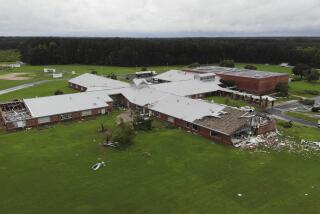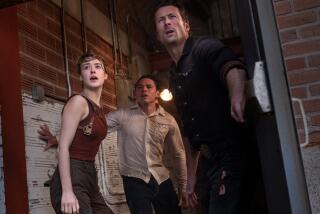6 Left Dead as Twisters Level S.D. Hamlet
When the sun emerged Sunday over the flatlands of eastern South Dakota, it exposed two dozen clapboard houses in an expanse of rubble that hours earlier had been the town of Spencer, a place blasted from Earth the night before by a lethal devil’s fork of tornadoes.
A trio of rumbling black funnel clouds, one a quarter of a mile wide, converged in a fury of whirlwinds on Spencer at dusk Saturday, scattering nearly every vestige of civilization. The torrent of winds killed at least six residents and injured 150, many of them elderly men and women who had settled into a quiet life in the rural town of 300 after decades spent farming the fields nearby.
Powering across the level Dakota landscape at 30 mph, the tornadoes that erased much of Spencer were the most devastating pincers of a volatile storm front that unleashed gusts of hurricane-force winds in some Wisconsin and Michigan counties and peppered much of the upper eastern plains with hail and driving rain.
The boiling, dark walls of wind that struck at Spencer appeared to gather within moments, witnesses said, materializing with such speed and devastation that they knocked out the town’s electricity and disabled its storm sirens before they could sound.
“There wasn’t any warning, but it didn’t matter,” said Mary Haupt, 36, who ran screaming into a field south of Spencer to find her husband, Tim, 40, as the black horizon filled with debris. “The clouds came up too quick. We had just enough time to get into the house and down in the basement.”
The Haupts cowered under a heap of blankets for three minutes as their farmhouse shook and the air thudded. When they emerged, the sun was still fading. Outside, around them was a tableau of rural devastation. Their barn was a shambles of splintered wood and equipment. Across the road, at a neighbor’s farm, panicked cows lowed in fright near the carcasses of cattle that had been hurtled through the air.
About three miles to the north, the town of Spencer had been flattened into a bristly carpet of wood, concrete and metal. The clipped frame hulks of a few homes poked out of the piles. The town’s 120-foot-high water tower lay toppled, snapped off its metal legs. A semi-rig truck was upended in a tree. The walls of one service station were shorn away, leaving a car sitting on a hoist, still waiting for a mechanic.
*
Lyle Weber, 41, one of the first rescue workers to reach Spencer, was unnerved by the town’s silence. The winds had died down as if they had never come. Stunned inhabitants stumbled through streets clogged by the remains of their homes. Few cried or spoke, Weber said, they “just kept walking around. A lot of them, we had to ask them questions to get anything out of them.”
“As far as you could see there was debris,” said Weber, who arrived with four fellow volunteer firefighters from the neighboring town of Alexandria. “Most of the houses were just sticks. You’d never know that a town full of people lived there.”
Weber and his crew worked through the night as hundreds of police, rescue crews, a 100-man inmate crew and National Guard units arrived to restore order, search for the missing and bulldoze the debris off the streets. On Sunday morning, search dogs were brought in to find the missing--but by midday, all residents had been accounted for, authorities said.
At least 90% of the town was “plumb gone,” Spencer Mayor Rocky Kirby said as he surveyed the wreckage where four churches, a bank and a post office stood. He admitted he is unsure if it is even worth rebuilding. One among scores of plains towns that have hemorrhaged population in recent decades, Spencer is a shrinking haven for farm retirees and workers who commuted to Sioux Falls, 45 miles to the east.
South Dakota Gov. William Janklow, who toured the site Sunday with Kirby, left shaken, comparing the town’s ruins with “a combat zone, like Hiroshima, like Nagasaki.” Janklow said he asked the Federal Emergency Management Agency for disaster aid. FEMA teams were dispatched.
Several of the dead were pulled from the debris of assisted-living apartments for the elderly on what had once been Main Street. Lyle Weber, whose crew helped retrieve the bodies, was too distraught to describe what had happened to the tornadoes’ victims. What stayed in his mind were the vaporized apartments themselves, “a two-story duplex with the bottom half somewhat still there. The top half completely blowed off.”
Despite the silence from the town’s sirens, some residents in the area knew enough from television and radio weather updates that a major storm was gathering. Lawrence Roster, 65, a shorthorn cattle farmer who lives four miles west of Spencer, said TV programs were interrupted by tornado bulletins minutes before the winds raised up.
Roster watched as one of the funnel clouds reached down from swirling black clouds and advanced on Spencer. “You could see a huge ball of dust at the bottom where it was sucking up everything in its path,” Roster said. “I feel sorry for anything that got in its way.”
At least five funnel clouds were reported in neighboring Alexandria, officials said. Other small tornadoes touched down without much effect elsewhere in the upper Midwest as thunderstorms raced over the region Saturday night, delivering winds as high as 100 mph and leaving showers of hail and rain.
The driving wind and rain left 900,000 homes and businesses without power in Minnesota, Wisconsin and Michigan, and killed five others, authorities said. Sudden squalls had gusts as high as 107 mph in Dodge County, Wis., and 92 mph near Grand Rapids, Mich. Toppling trees killed a camper in his tent in Michigan and a live wire electrocuted a utility repairman in Grand Haven, Mich. Another man died in Wisconsin when his car hit a downed tree.
*
Near Spencer, Mary Haupt was listening to the storm reports on her radio when she looked out her kitchen window.
Before her, the horizon had metamorphosed into “this giant black wall,” pulsing with lightning and hail. She ran to find her husband, who was out in the fields. He followed her back into the house.
The walls and glass shuddered overhead as they lay in their basement. They felt the change in air pressure. “It felt like the winds were sucking all the air out of the house,” Mary Haupt said later. Hail began falling like buckshot.
Not until the clatter subsided and the sun shone again were they ready to go upstairs. The Haupts’ barn had collapsed, but the funnel cloud had veered away from their farmhouse toward a neighbor’s property. The neighbor’s house lay in ruins. Tractors and machinery stored in their shed lay in tiny, twisted parts around the grounds, as if disassembled by meticulous pranksters. The neighbors, in their 50s, were unhurt but stunned.
“People always say it sounds like a freight train,” Mary Haupt said. “But this was worse; tin and glass and metal rattling and the house vibrating. It was the longest three minutes I’ve ever had.”
Terrified under the blankets, she wept and prayed “that the Lord would save us, and he did. I guess we were lucky, but it takes more than luck when you’ve got a big, black wall flying at you. I just wish the town had their prayers answered the way ours were.”
*
Braun and Beckham reported from Chicago.
More to Read
Sign up for Essential California
The most important California stories and recommendations in your inbox every morning.
You may occasionally receive promotional content from the Los Angeles Times.










